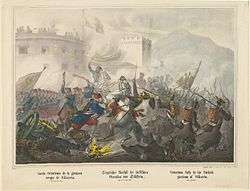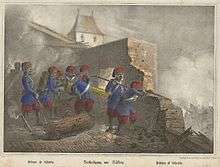Siege of Silistra
| Siege of Silistra | |||||||
|---|---|---|---|---|---|---|---|
| Part of the Crimean War | |||||||
 Victorious sally by the Turkish garrison of Silistria | |||||||
| |||||||
| Belligerents | |||||||
|
|
| ||||||
| Commanders and leaders | |||||||
|
Musa Hulusi Pasha Omar Pasha |
Field Marshal Ivan Paskevich Prince Mikhail Gorchakov | ||||||
| Strength | |||||||
| 18,000[1]:184[2]:256 |
45,000[3]–up to 90,000 266 cannons[1]:184[4] | ||||||
The Siege of Silistra took place during the Crimean War. In this action, Russian forces besieged the Ottoman fortress of Silistra. While initially successful, the Russians were forced after several weeks to abandon the siege and retreat due to political pressure.[5][3]
Background

This battle took place during the Danube campaign of the Crimean War. In the spring of 1854, following the winter lull in campaigning, the Russians determined to advance into Ottoman territory. In the east an army numbering 45,000 under General A. N. Luders crossed the border from Bessarabia into Dobruja to occupy various strong points there. By the beginning of April the Russians were at the site of Trajan's Wall, 30 miles east of Silistra. Meanwhile, the central force under Prince Mikhail Gorchakov had crossed the river and had advanced to lay siege to Silistra itself. At Silistra an Ottoman force of 20,000 was encamped in the town, which was heavily fortified.
Action
In 1854 Silistra was fortified with an inner citadel and a ring of ten outer forts. By May the garrison in the citadel itself numbered 12,000,[6] while outside there was a mobile army maintaining contact and supply routes.
On 5 April the vanguard of the Russian force under General K. A. Schilder arrived at the fortress and commenced building entrenchments. However, they were unable to completely surround the town, and the Ottoman forces were able to keep the garrison supplied. On 22 April Field Marshal Prince Ivan Paskevich, the commander of all Russian forces, arrived to take charge of the siege.
By May, reinforcements arrived to the Ottomans, increasing the number of their troops to 18,000,[1]:184[2]:256 and the bombardment of the town started in earnest. On 28 May a key outwork, the heavily fortified fort of Arab Tabia, was assaulted and briefly captured, but the attackers were left without support and were ordered to withdraw, losing 700[7]:17 or 933 men in total, including General Dmitriy Selvan, who was mortally wounded in the assault.[1]:185[8] Official Ottoman proclamations announced that the Turkish losses were 189 men.[1]:185 Musa Pasha, a Turkish commander, was among the dead.[1]:185
On 10 June Paskevich claimed to have been hit by a shell fragment during an artillery duel. Although he was not wounded, he retired and his place was taken by Prince Gorchakov.[9] On 13 June Schilder was also wounded and died shortly after.
On 20 June another assault on the Arab Tabia was successful, opening the way for an assault on the main citadel. However at 2am on 21 June, just two hours before the assault was due to take place, Gorchakov received orders from Paskevitch to raise the siege and return to his positions north of the Danube. This was done by 24 June.[1]:186 The overall Turkish casualties are unknown, whereas the Russians lost 419 dead and 1783 wounded during the siege;[10]:65[3] however, thousands more of their soldiers were sick.[11]:134 The British wartime press declared that Paskevich lost up to 10,000.[12][13]
Aftermath
The order to retreat was forced by diplomatic pressure and the threat of military action by the Austrians, who were increasingly concerned about Russian intentions in the area.[14][3] The failure of the siege signaled a general withdrawal by Russia from the Principalities, which was largely completed by September 1854.
References
- 1 2 3 4 5 6 7 Badem C. The Ottoman Crimean War. BRILL. 2010
- 1 2 Reid J. J. Crisis of the Ottoman Empire: Prelude to Collapse 1839-1878. Franz Steiner Verlag. 2000
- 1 2 3 4 Clodfelter M. Warfare and Armed Conflicts: A Statistical Reference to Casualty and Other Figures, 1500-2000. McFarland, 2002. P. 200
- ↑ M. Bogdanovich. The Eastern War
- ↑ Crimean War (1853-1856), Eric v.d. Luft, Ground Warfare: A-G, Vol. I, ed. Stanley Sandler, (ABC-CLIO, 2002), 219.
- ↑ Agoston G., Masters B. A. Encyclopedia of the Ottoman Empire. Infobase Publishing. 2010
- ↑ Russell W. H. General Todleben's History of the Defence of Sebastopol, 1854-5: A Review. Cambridge University Press. 2012
- ↑ Y. Tarle, The Crimean War
- ↑ Figes, Orlando (2010). The Crimean War: A History (1st ed.). New York, New York: Metropolitan Books. p. 175. ISBN 978-0-8050-7460-4.
- ↑ Ponting C. The Crimean War: The Truth Behind the Myth. Random House. 2011
- ↑ Arnold G. Historical Dictionary of the Crimean War. Scarecrow Press. 2002
- ↑ Morell J. R. The Neighbours of Russia. T. Nelson and Sons, 1854. P. 254
- ↑ Siege of Sillistra, Nineteenth-century Land Warfare: An Illustrated World View, ed. Byron Farwell, (W.W. Norton & Co., 2001), 760.
- ↑ Crimean War (1853-1856), Eric v.d. Luft, Ground Warfare: A-G, Vol. I, ed. Stanley Sandler, (ABC-CLIO, 2002), 219.
Further reading
- Baumgart, W (1999). The Crimean War 1853-1856. ISBN 0-340-61465-X.